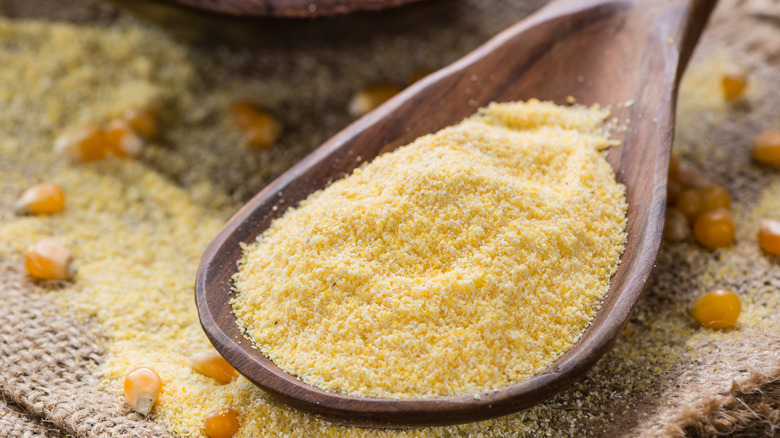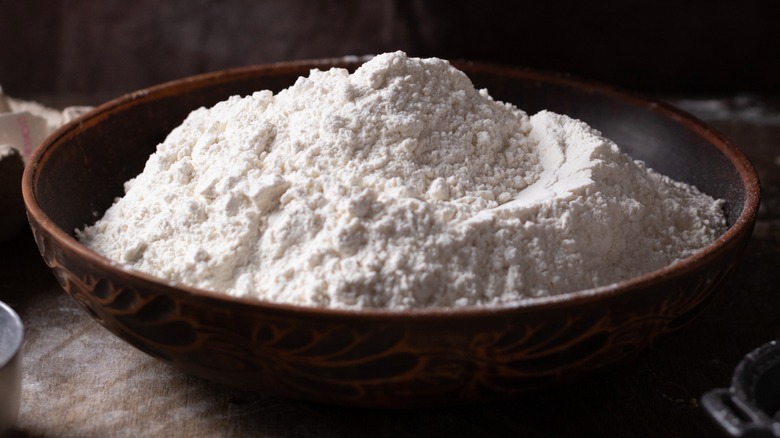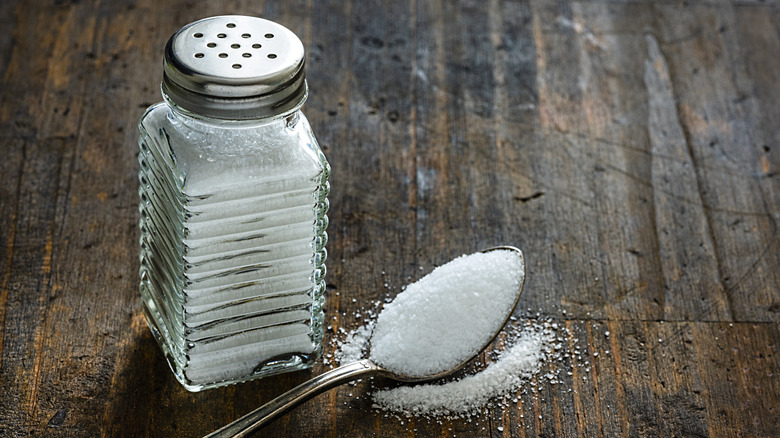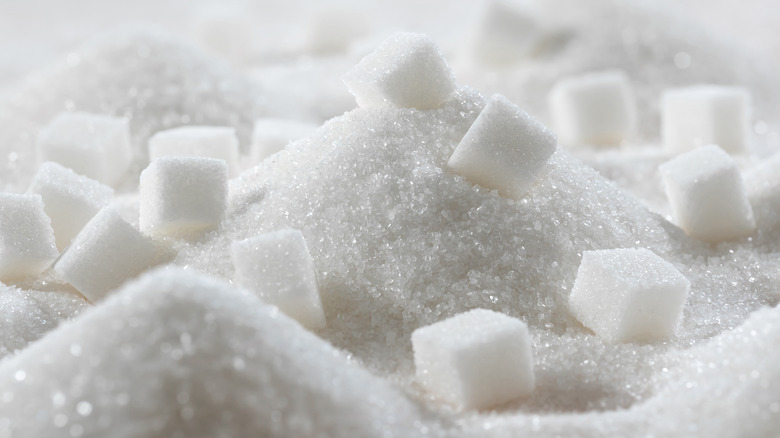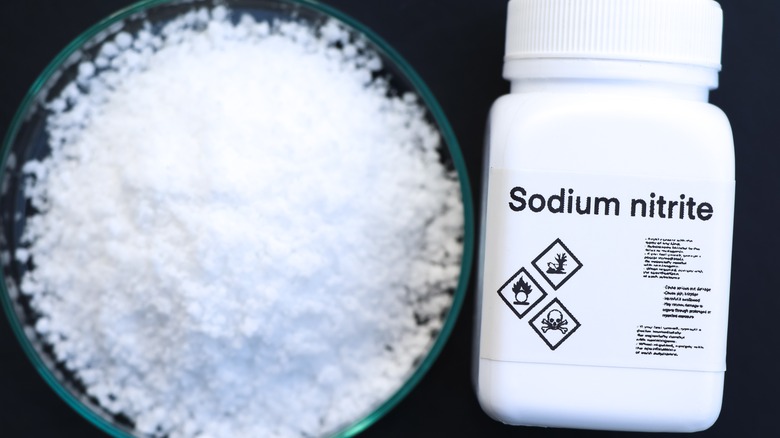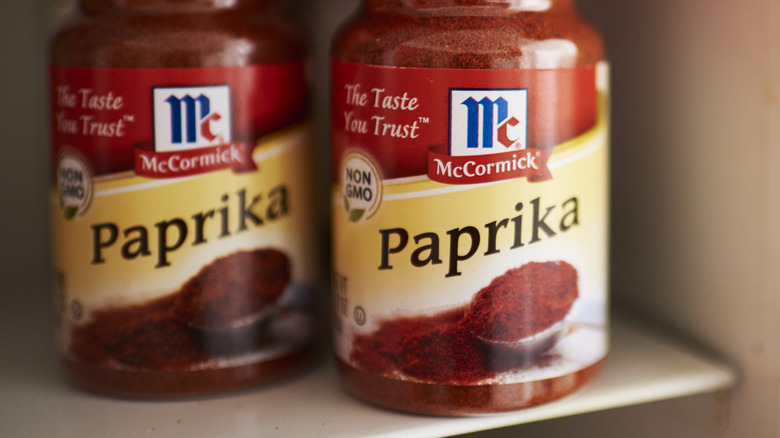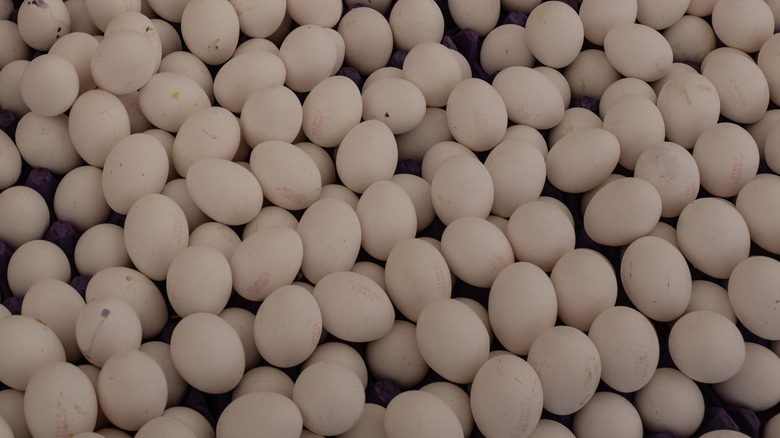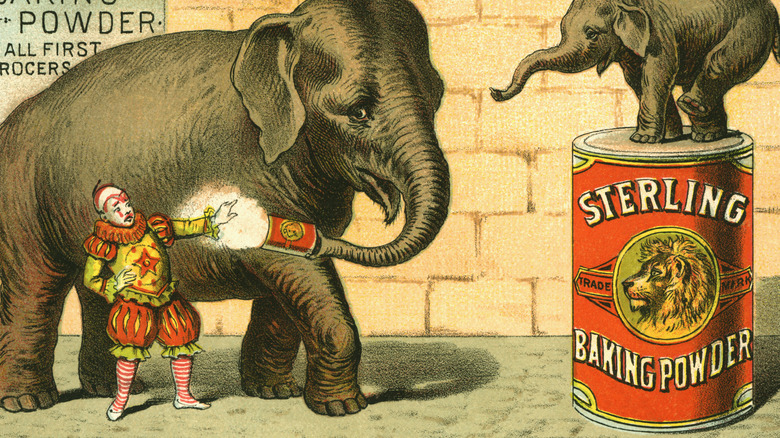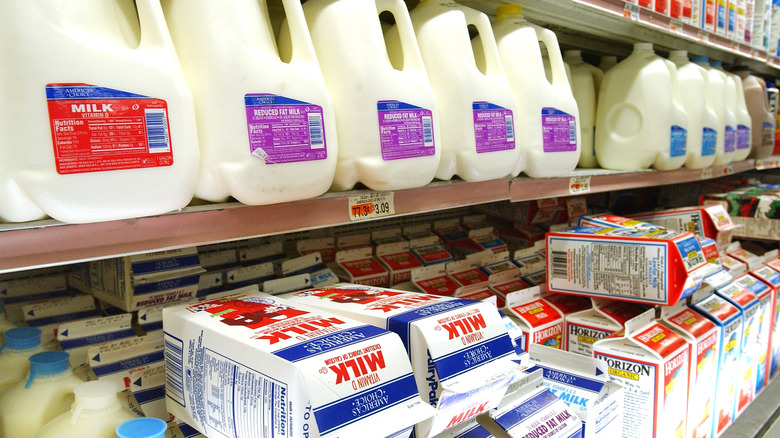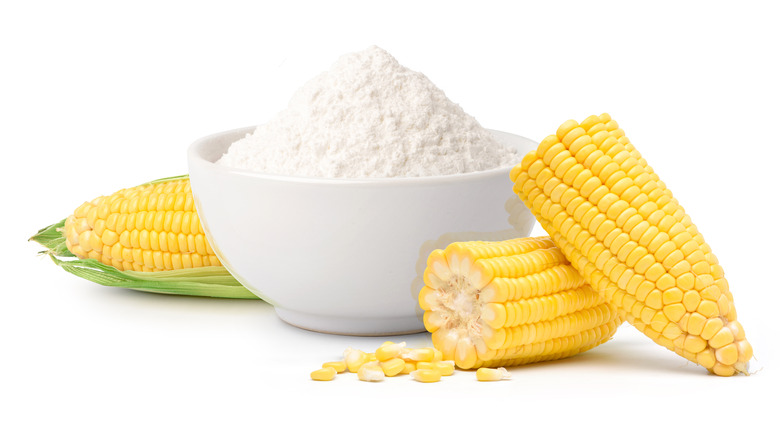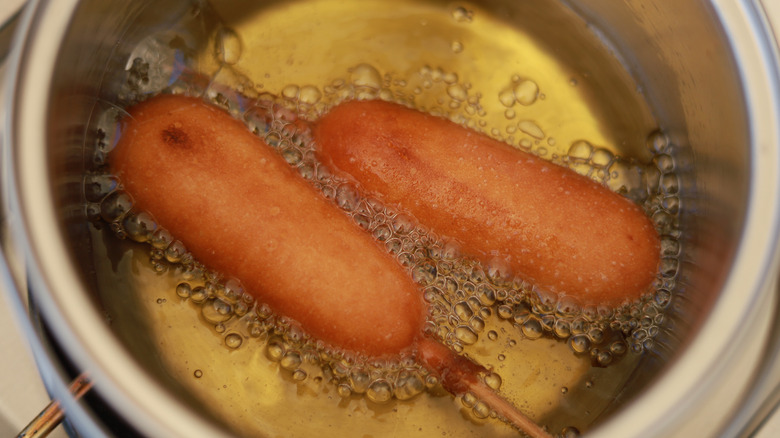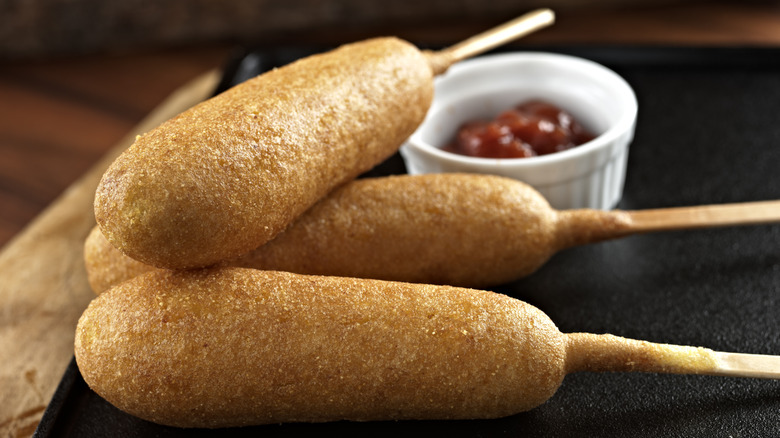What You're Really Eating When You Bite Into A Corn Dog
We love the inherent diversity of the great melting pot that is the United States of America. But if there's one quibble we have with living in a nation composed almost entirely of immigrants from every imaginable corner of the world, it's the subsequent limit on wholly American culinary creations. In that sense, we tend to hold any truly American foods near and dear to our heart, hence our unabashed affection for the corn dog.
A sweet and salty culinary marvel, the humble corn dog is why some folks are convinced more meat-on-a-stick options should be available. After all, though the precise details of the origin of the corn dog may be a bit murky — at least in regard to who first invented it (and when) – no one could ever conceivably question the mouthwatering nature of this state fair and carnival staple.
Now, everyone knows corn dogs are made for walking (like Nancy Sinatra's boots). But far fewer folks likely have a firm grasp on what's actually inside the all-American treat beyond, well, corn and hot dogs. With that in mind, we decided to take a deeper look at this corn-battered, stick-based concoction, and reveal what you're really eating when you bite into a corn dog.
Some sort of meat
Even if you're oblivious to the other ingredients, you're almost certainly aware that a corn dog can only exist if it contains a hot dog. But given the oft-parodied nature of what's actually in hot dogs, it may be more informative to elaborate further on how the sausage is made, so to speak ... or, well, quite literally. So rather than simply state you're eating a hot dog and leave it at that, we'll instead declare that virtually every corn dog contains some type of meat via its hot dog component and may even contain multiple different animal-derived proteins.
A quick gander at various hot dog brands reveals a wide range of meats potentially contained within the casing of your corn dog's main ingredient. For instance, some corn dog brands are made with all-beef hot dogs, while others are filled with poultry, such as turkey and-slash-or chicken. A corn dog's internal component may consist of the leftover trimmings from butchered pork, of course, and certain brands, like Ball Park classic corn dogs, are made with the former flesh of cows, pigs, and turkeys.
To be sure, in the 2020s, corn dog brands made with plant-based hot dogs are available for purchase. But for the most part, if you eat a corn dog, there's a better-than-average chance you'll find yourself ingesting meat, or a combination of meats, in the process.
Cornmeal
Just as the second half of this food item's name implies, understanding the "corn" part of a corn dog might seem fairly straightforward. Yet merely stating corn surrounds the exterior of a corn dog offers little to no insight as to what you're eating when you bite into one (and greatly undersells the actual ingredients included). Still, there's no denying the corn-derived product known as cornmeal is central to a corn dog's creation – meaning once you reach for the food's wooden stick, you're guaranteed to consume cornmeal.
Now, if you're unfamiliar with cornmeal as a food product, you may not realize it's basically dried, ground-up corn kernels. While there's no uniform texture to be found with commercially sold cornmeal, considering it forms the basis of the batter in which a corn dog is dipped prior to cooking, we'd bet the cornmeal you're eating with your corn dog is finely ground rather than coarse.
Interestingly enough, cornmeal may not be the only corn-based ingredient found in your corn dog, although it's probably the only one with the word "corn" right in its name.
Flour
As the Sara Bareilles-penned musical "Waitress" (based on the 2007 film of the same name) reminds us, we know "what's inside" every scrumptious baked good: sugar, butter ... and flour. Now, we're not sure how many folks would categorize corn dogs alongside baked foods in general — even those who prefer to prepare frozen corn dogs in the oven. But when you ponder the corn muffin-style flavor and texture of a corn dog's cooked batter, it's easy to ascertain how and why flour is prominently involved in preparing the food.
Does it go without saying that the flour contained inside a finished corn dog isn't in the dog part, but rather the corn portion? It might. But we're nothing if not thorough. So, if it's still unclear, the flour found in a corn dog is used for creating the batter and not contained within the hot dog or the wooden stick.
Of course, assembling a corn dog's exterior component requires more than just flour and cornmeal. But with very few feasible alternatives to flour for the purpose of crafting corn dog batter, any gluten-sensitive individuals may prefer to steer clear of this gastronomic extravagance in the future.
Salt
The chemistry of the human brain — specifically, the way substances like sugar and fat physiologically interact with this insanely intricate organ — helps explain salt's mind-boggling worldwide popularity. But the practical explanation for salt's nigh-universal presence in modern foods is much simpler to uncover — it adds unparalleled flavor to virtually everything. Long story short, the inclusion of edible sodium chloride in delicious food products is usually a given, and corn dogs are no exception.
We can confidently say that no matter the corn dog at your disposal, salt will be included in some capacity. This is true whether we're talking about a store-bought variety, one grabbed at your local 4-H fair, or a homemade version.
Since salt enhances the taste of literally anything it's added to while concurrently hitting the pleasure centers of the brain, predicting the ingredient will be found in your corn dog is elementary.
Sugar
As you may be aware, there's an entirely exorbitant amount of sugar added to essentially everything modern consumers eat. In that regard, if you're eating a corn dog, we presume you can guess which ingredient is all but assured to be included.
Not unlike salt's predicted presence in corn dogs, it's essentially guaranteed that sugar — in one form or another — is going to be found in any corn dog you eat. Much of the time, it's added as honey to the batter, although there's likely some generic granulated sugar to be found in many corn dogs, as well.
Of course, while sugar activates the human brain's reward centers in a similar manner as salt (consequently making a person crave more of that substance), its inclusion isn't exactly related to inducing corn dog hankerings in diners. In fact, the ingredient is vital to a successful corn dog, as the subtle sweetness ensconced within the outer, cornmeal-based batter acts as a saccharine counter to the hot dog's salty, smoky flavor.
Sodium nitrite
To say hot dogs are a highly processed foodstuff may be the understatement of the century ... though, it's still fairly early in the 21st century. Still, the sheer fact that these tube-shaped delights are not known as beacons of a natural diet leads us to the next ingredient on our list. Whether the brand in question utilizes an artificial variety, or a natural version such as celery juice, you're set to ingest sodium nitrites when eating the hot dog wrapped inside your corn dog.
Now, the controversial nature of sodium nitrites (and sodium nitrates) as a food preservative is impossible to ignore. But at the exact same time, well ... we're nothing if not reasonable. So, while the potential health risks found from long-term ingestion of foods containing sodium nitrites is worth considering, we also understand that large-scale manufactured food products, such as hot dogs, won't appeal to many customers without a long shelf life to delay spoilage.
Perhaps some individuals are prone to balk at the notion of ingesting sodium nitrites out of fear of its potentially detrimental nutritional impact. But if you're determined to down a corn dog, you'll have to be prepared to consume some form of sodium nitrite in the process.
Paprika
Like Bryan Mills in "Taken," there's a very particular set of flavor notes one expects to find within a hot dog. With that in mind, one of the more common spices used during the production of hot dogs — aka the most iconic summer food – is paprika. And if you're savvy enough to connect the dots, you're likely aware that when you bite into a corn dog, there just might be some paprika entering your digestive system.
Actually, it's not simply ground and dried paprika that often (but not always) appears as an ingredient in a corn dog's central item. In addition to the classic spice, many hot dogs, including those used in some popular corn dog brands, also contain paprika oleoresin. In fact, at least one variety (Bar-S Classic Corn Dogs) appears to exclusively use paprika oleoresin — a pepper extract used to enhance various food items' red color while adding natural flavor — rather than the ground spice itself.
Still, with a strong likelihood that paprika or paprika oleoresin will be found in any corn dog's hot dog, it's presumably best for anyone with a heat-challenged palate to prepare themselves for the reliably spicy spice.
Eggs
Of the many, many food shortages we've been forced to experience or prepare for in 2023, few have been as painfully felt — to consumers' wallets, we mean — as eggs. Thankfully, though, as of July 2023, our long nightmare involving the proto-chicken breakfast staple has (knock on wood) begun to recede. This means anyone hoping to prepare a corn dog from scratch can rejoice, as eggs — a necessity for producing the proper cornbread-like batter — will no longer break one's food budget.
Quite frankly, the idea that anyone would attempt to understate raw eggs' importance to creating a perfect corn dog batter — or even a passing one, for that matter — is implausible. Eggs are essential to any number of baked goods, after all, and since the food is known to ensure batter stays intact and moist during the cooking process, it doesn't take a massive leap in logic to see how it's usually essential to corn dogs.
Now, we may not have the ability to check every single corn dog recipe or ingredient list in the world. But as seen with numerous homemade recipes, and countless popular corn dog brands, the food is extremely likely to require eggs ... unless one of the many vegan-friendly alternatives to eggs is on hand.
Baking powder, or soda, ot both
We've already acknowledged some of the reasons why a person may (or may not) consider labeling corn dogs as a baked good. But no matter where you stand on that issue of nomenclature, the fact remains that the scientific realities leading to a top-notch corn dog batter aren't mutually exclusive from cornbread baked in the oven. In other words, if you're somehow surprised to see baking powder and the related (but not identical) baking soda in a corn dog recipe, perhaps you shouldn't be.
We'll spare you a nitty-gritty analysis detailing the differences between baking powder and soda, since that's not the type of article you're reading; suffice it to say, one has an additional acid component (baking powder), while the other (baking soda) does not. Besides, the precise chemical mechanisms of how baking powder and-slash-or soda interacts in a corn dog batter isn't really relevant for our purposes; we're only detailing what you're really eating when you bite into a corn dog. And since many homemade recipes, and store-bought brands, utilize one or both of these ingredients, it's no mystery why you should expect to ingest these pantry staples with your next corn dog.
Milk or buttermilk
For any readers under the mistaken impression that eggs are solely responsible for the moisture found in a corn dog's cornbread-adjacent batter, allow us to correct the record. After all, eggs are far from the sole wet ingredient used when making corn dogs — the additional use of milk (or buttermilk, depending on the recipe) is all but assured. This, of course, indicates you'll be eating one of the two dairy liquids when you bite into a corn dog, so lactose intolerant individuals should beware.
Now, while we'd love to take the time to break down the underlying chemical processes that make milk or buttermilk necessary when preparing corn dog batter, as we've mentioned elsewhere, that's not the point of this article. And though use of either of the two aforementioned milk products used in corn dogs won't mean much to most folks, it's hardly an irrelevant detail to anyone leery about ingesting dairy. This may simply mean anyone unable (or unwilling) to consume dairy products will want to look for a vegan-friendly or dairy-free corn dog whenever possible.
Cornstarch
By this point, any conscientious readers fully comprehending the ingredients we've noted as corn dog necessities know the "corn" part of corn dogs is mainly related to the cornmeal. Yet there's a secondary corn-derived ingredient commonly found in this popular food item that's often just as essential to creating a perfectly crisp final product. Or, at the very least, any homemade corn dogs are likely to contain cornstarch in addition to cornmeal.
Now, while several well-known chefs, including Alton Brown, choose to lightly coat their hot dogs in cornstarch before dipping the food into cornmeal batter, not every corn dog recipe utilizes this common thickening agent. In fact, the absence of cornstarch among listed ingredients for some popular frozen corn dog brands indicates the ingredient may not be universally found in the food unlike, say, cornmeal or hot dogs.
For anyone consuming a freshly made corn dog, though, the odds are that cornstarch will be included. We can't promise it'll be found in every single corn dog on the market ... but we are willing to predict a great many corn dogs incorporate this secondary corn ingredient.
Vegetable oil (depending on how it's prepared)
In all honesty, our initial instinct was to mock anyone willing to consider the notion of a vegetable oil-free corn dog. But that's not really our style. More to the point, even if you choose to bake a frozen corn dog — rather than frying it in a pot of bubbling vegetable oil of some sort, as God intended — there's an exceptionally strong chance you'll still be eating a version of this common cooking oil when biting into the stick-speared product.
If you're wondering how this could possibly be, consider the fact that the vast majority of frozen corn dogs sold by supermarkets are pre-cooked rather than raw. Now, we suppose it's possible that some industrial-sold corn dogs aren't prepared in vegetable oil prior to freezing. But a glance at several prominent frozen brands plainly displays the product was cooked in vegetable oil before packaging.
Clearly, then, there's a great likelihood that you're eating vegetable oil when you bite into a corn dog, but who's complaining?
A wooden stick
There's one part of the corn dog that isn't generally eaten and probably shouldn't be, but it's as vital to the food as cornmeal or frankfurters — the stick. Keep in mind that if you lick it clean or bite off those crusty, nearly burnt last bits of batter, you might be ingesting slight traces of that wooden spine.
The variety of available commercial woods means corn dog manufacturers can choose the most suitable for sticks, and more often than not, they go with white birch, also known as Canadian birchwood. The product is durable, and almost entirely devoid of flavor or scent, making it a good choice for wood products that go in the mouth like popsicle sticks, chopsticks, skewers, coffee stirrers, toothpicks, and corn dog sticks. The wood is processed and smoothed out to decrease the likelihood of splintering; then it's flattened into sheets and machine-cut down to corn dog length. Finally, it's placed inside the battered wiener to hold everything together and serve as a built-in handle.


